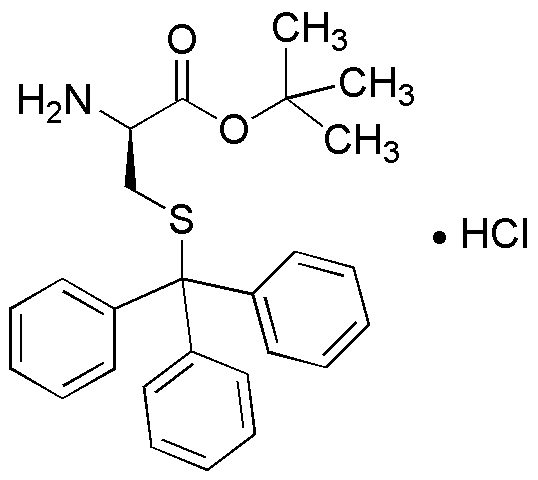S-Trityl-D-cystine tert-butyl ester hydrochloride is widely utilized in research focused on:
- Peptide Synthesis: This compound serves as a protecting group in the synthesis of peptides, allowing for the selective modification of amino acids without affecting others. This is crucial in creating complex peptide structures used in drug development.
- Bioconjugation: It facilitates the attachment of biomolecules to surfaces or other molecules, enhancing the development of targeted drug delivery systems. This application is particularly beneficial in the pharmaceutical industry.
- Antioxidant Research: The compound is studied for its potential antioxidant properties, which can help in developing therapies for diseases linked to oxidative stress, such as cancer and neurodegenerative disorders.
- Protein Stabilization: It is used to stabilize proteins during purification processes, ensuring that they maintain their functional integrity. This is essential for researchers working on enzyme studies or therapeutic protein production.
- Drug Formulation: The compound plays a role in the formulation of new drugs, particularly those that require specific solubility or stability characteristics, improving their efficacy and shelf-life.
General Information
Properties
Safety and Regulations
Applications
S-Trityl-D-cystine tert-butyl ester hydrochloride is widely utilized in research focused on:
- Peptide Synthesis: This compound serves as a protecting group in the synthesis of peptides, allowing for the selective modification of amino acids without affecting others. This is crucial in creating complex peptide structures used in drug development.
- Bioconjugation: It facilitates the attachment of biomolecules to surfaces or other molecules, enhancing the development of targeted drug delivery systems. This application is particularly beneficial in the pharmaceutical industry.
- Antioxidant Research: The compound is studied for its potential antioxidant properties, which can help in developing therapies for diseases linked to oxidative stress, such as cancer and neurodegenerative disorders.
- Protein Stabilization: It is used to stabilize proteins during purification processes, ensuring that they maintain their functional integrity. This is essential for researchers working on enzyme studies or therapeutic protein production.
- Drug Formulation: The compound plays a role in the formulation of new drugs, particularly those that require specific solubility or stability characteristics, improving their efficacy and shelf-life.
Documents
Safety Data Sheets (SDS)
The SDS provides comprehensive safety information on handling, storage, and disposal of the product.
Product Specification (PS)
The PS provides a comprehensive breakdown of the product’s properties, including chemical composition, physical state, purity, and storage requirements. It also details acceptable quality ranges and the product's intended applications.
Certificates of Analysis (COA)
Search for Certificates of Analysis (COA) by entering the products Lot Number. Lot and Batch Numbers can be found on a product’s label following the words ‘Lot’ or ‘Batch’.
Número de catálogo
Número de lote/lote
Certificates Of Origin (COO)
This COO confirms the country where the product was manufactured, and also details the materials and components used in it and whether it is derived from natural, synthetic, or other specific sources. This certificate may be required for customs, trade, and regulatory compliance.
Número de catálogo
Número de lote/lote
Safety Data Sheets (SDS)
The SDS provides comprehensive safety information on handling, storage, and disposal of the product.
DownloadProduct Specification (PS)
The PS provides a comprehensive breakdown of the product’s properties, including chemical composition, physical state, purity, and storage requirements. It also details acceptable quality ranges and the product's intended applications.
DownloadCertificates of Analysis (COA)
Search for Certificates of Analysis (COA) by entering the products Lot Number. Lot and Batch Numbers can be found on a product’s label following the words ‘Lot’ or ‘Batch’.
Número de catálogo
Número de lote/lote
Certificates Of Origin (COO)
This COO confirms the country where the product was manufactured, and also details the materials and components used in it and whether it is derived from natural, synthetic, or other specific sources. This certificate may be required for customs, trade, and regulatory compliance.


